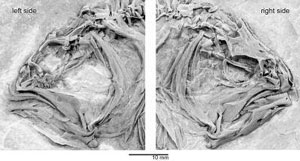Sign #6: “Intermediate form supports flatfish evolution”
Flounder, sole, halibut and other flatfish have long struck biologists as evolutionary oddities: Both their eyes are on one side of the head, an adaptation that allows them to lie flat on the ocean bottom while keeping their eyes on the lookout for passing prey. The transition happens in the youth of flatfish, one eye migrating up and over the top of the head. Opponents of evolution argued that this curious anatomy could not have evolved gradually, as suggested by the theory of natural selection. That’s because there would be no advantage for an intermediate form –a fish with an only partially migrated eye. But now scientists have found those intermediate forms in museum collections. The 50 million-year-old fossils, including Heteronectes chantei shown here, have a partially displaced eye.
When flatfish die today they are not generally fossilized. Scavengers continue to eat their remains until there is nothing left. To fossilize a flatfish you need to bury it under sediment quickly. If a young flatfish was suddenly buried when its eye had only migrated part of the way around its head it would look just like the fossil pictured. It would not be a new species.
The sedimentary rocks of the world are filled with fossils that point to rapid burial. One example is a fish entombed in the act of swallowing another fish. Another is an ichthyosaur snap frozen in sediment while giving birth. The global Flood described in the Bible explains why we find so many fossils buried in sediment laid down by water all over the earth. Buried only 4,500 years ago, not 50 million years, sign # 6 is a powerful sign for creation.
Source: Creation Ministries

No comments:
Post a Comment
Note: All comments that contain inappropriate or off-topic material will not be approved. Also, generally posts that contain links/URLs will not be approved.